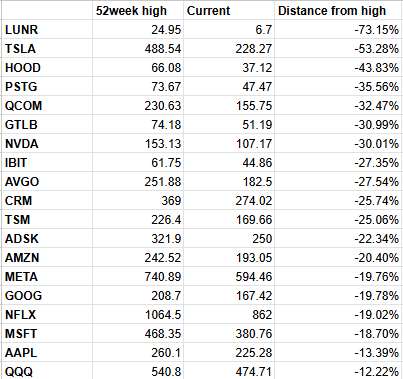Trade Alert – Trading one tech supplier for another (and some updated analysis on Apple)
I’m not changing my stance on Apple. I’m holding onto a large common stock position with huge gains that I’ve owned for years and I’m sitting on losses from the recent call options I’d scaled into. I do expect that Apple can and will deliver nearly $60 in earnings this year, and I expect that the market will pay 10X those earnings, plus net cash, which would put the stock up near $750 or $800. And I still expect that we’ll see a $1000 price in AAPL sometime in 2014 or 2015. There are no sure things though, and that’s why we diversify and clearly our other longs have been huge winners of late even as Apple’s own shareholders have relentlessly sold the stock down here that they loved at $700.
Steady as she goes. Let’s find the next Revolutionary Investment right here, right now.
Successful trading and investing aren’t only about finding undervalued stocks with great growth potential. Sometimes, it’s a little more like middle school. Popularity matters, and it can push an overvalued issue to ridiculous heights or leave a great bargain languishing for months. This week, we’re making a change in the Revolution Investing portfolio, not because we think the underlying thesis on Broadcom has changed, but because I think we’ve got a better risk/reward potential in a similar company.
To recap, Broadcom makes semiconductor solutions for wired and wireless computing. That means smartphones and tablets, and specifically, we liked Broadcom because of its status as an Apple supplier and its potential to ride the Apple wave into the cloud and TV-land. We’ve made a little more than 4% on BRCM since we bought it in June. We can do better.Today, we’re selling our shares in Broadcom and buying Nvidia, which is both a chipmaker in the mobile space and also the dominant PC graphics card maker. Investors have been shy because of falling PC sales, but the company is hugely undervalued and stands to benefit from the nascent (yes, it’s still nascent) explosion in smartphones and tablets. First let’s look at the numbers.
At $12.61 per share, NVDA’s market cap is just under $7.9 billion, but there’s $3.4 billion in net cash on the books here. That means that, effectively, you’re buying the business for about $7.14 per share, and the company’s enterprise value is less than $4.5 billion. This year (fiscal year 2014, ending in January), Nvidia is projected to do $4.54 billion in revenue and post earnings of $0.96 per share. Translation? This company, which is positioning itself to ride the smartphone/tablet tsunami, is trading for less than 1x revenue and just 7.4x projected earnings. Add to that a recently declared dividend, currently yielding 2.4%, and you can see already why my Spidey senses are tingling.
Now let’s talk about the operational and competitive environment. Nvidia is the largest supplier of graphics add-in boards, which are used in desktop PCs, workstations and servers. In the consumer space, gaming is the key driver for higher end graphics. Nvidia’s new Kepler line of graphics cards has performed well in this space, and while PC sales are falling, gamers like to upgrade their graphics capacity regularly. The Kepler generation offers strong performance per watt from a gaming perspective, and is also considered superior from a software standpoint (drivers, features, etc.). In the third quarter, Nvidia took share from number two AMD, and according to Jon Peddie Associates, the company controlled 64% of the market for graphics add-in boards. This trend probably continued in the fourth quarter. In the enterprise space, the gradual economic recovery should help to kick-start sluggish professional graphics spending, which is a very high margin business (50%+) for Nvidia. Lastly, Nvidia is supplying the graphics cards for Apple’s iMac and Macbook Pro. Sales of these were supply- constrained in the latest quarter—but that may well indicate a surge in sales in the next quarter.
But the really exciting upside potential for Nvidia comes from its increasingly aggressive foray into mobile computing for smartphones and, particularly, tablets. Nvidia’s Tegra 3 platform is found in the popular Google Nexus 7 as well as in the Microsoft Surface and the ASUS Transformer Prime. Texas Instruments has exited the tablet chip business, leaving room for market share growth here as well, although Intel is getting into the business too. Qualcomm is the dominant player here, but Nvidia unveiled its Tegra 4 platform at the Consumer Electronics Show earlier this month. Tegra 4 supports LTE (4G) wireless networks, which will bring it up to par with Qualcomm’s Snapdragon line and make Nvidia more competitive in the smartphone space.
Even more interesting is word this week that Nvidia plans to start making white label tablets and smartphones itself, which smaller regional players will then brand and sell. This second-tier space for tablets and smartphones has previously been dominated by low quality Chinese-made devices. By designing and manufacturing the end products, Nvidia will have control over performance and quality and by marketing through local and regional players, it will get the volume necessary to buy components at a competitive price. The result should be a lower-priced device that truly competes with high-end models in terms of quality. The potential here is huge. Word is that some of these devices may carry the Nvidia or Tegra name, while others won’t (branding decisions being made by the local partners), and that these devices will become available by mid-year. This is the same approach that Nvidia took in the graphics card business, where it is now the dominant player. I’m not suggesting that Nvidia will unseat Qualcomm as the top mobile chip supplier (and we own Qualcomm in the portfolio), but given its upside potential and its very strong cash position, it looks like a long-term winner.
Investors have been avoiding the stock because of its reliance on PC gaming, but that’s why we like the shares now. Gamers are not going to stop upgrading their graphics cards, it’s a never-ending cycle. Meanwhile, Nvidia is pushing hard into the high growth tablet and smartphone arena, where a rising tide should lift all boats for the next several years. Three years ago Nvidia made just 7% of its sales in non-PC segments; in the latest quarter 30% of sales were non-PC related. Its chips are also used in a growing percentage of notebook computers. Inclusion of LTE connectivity in the Tegra 4 line brings Nvidia into the fold for smartphone market share and its plan to build quality, low-cost tablets has the potential to give the company a strong footing here too.
So to recap, we’re selling Broadcom and adding Nvidia common stock to the Revolution Investing portfolio.




